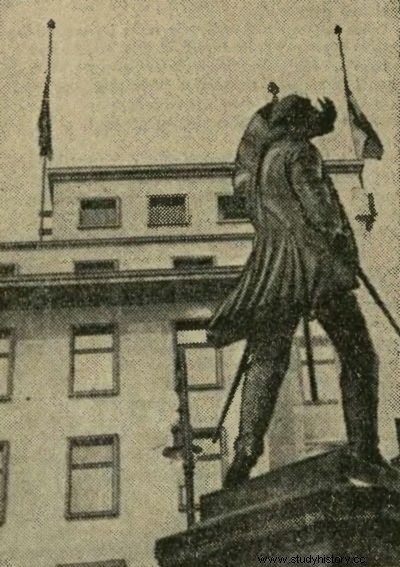Today is another anniversary of Józef Piłsudski's death. Probably the network will be flooded with comments again, in which there will be information about the national mourning, which Adolf Hitler was to announce after learning about the departure of the Polish leader. It's a lovely story, just completely made up. So how did Berlin say goodbye to the Commander?
The death of Józef Piłsudski was the end of an epoch in our history. Both Poles and representatives of other nations were well aware of this. After the Marshal's death, the press almost all over the world wrote about it. In many countries, more or less official mourning ceremonies were held in his memory.
Well, what about the national mourning in Germany?
In the minds of Poles, those arranged in Berlin remained the most persistent. According to a very vivid myth, Adolf Hitler, upon the news of Piłsudski's departure, was to announce a three-day national mourning throughout Germany on May 13. It is mentioned with fondness by Internet users; this topic can also be found in popular books by Sławomir Kopra. Repair is not factual information, but manipulation. Hitler did nothing of the sort .

Polish ambassador to Germany Józef Lipski welcomes Adolf Hitler on the steps of the Berlin Cathedral of St. Jadwiga just before the funeral service for the soul of Józef Piłsudski (source:public domain).
The Polish press from that period clearly wrote that the German chancellor issued a mourning ordinance applicable to the deaths of heads of state and that's something else entirely. It cannot be denied that it was a tribute to the Poles, because officially Piłsudski was only the minister of military affairs and the general inspector of the armed forces. But it has nothing to do with national mourning.
The essence of mourning in this case boiled down to the fact that on May 13 and 18 (the day of the Krakow funeral) flags were lowered on government buildings to the middle of the mast. The same was done in Germany with the deaths of other world and European leaders. Exactly the same was done in France, but hardly anyone remembers it today, and certainly not every move is written about the national mourning over the Seine.

After Piłsudski's death, no national mourning was introduced in Germany. Hitler, however, ordered the banners to be lowered to the middle of the mast on May 13 and 18. The photo shows such a flag on the Reich Chancellery (source:public domain).
It is true, however, that Hitler, along with other Nazi officials, attended a service held at St. Jadwiga. An interesting description of this celebration can be found in the diary of the American ambassador to Berlin, William E. Dodd. On May 18, he noted:
Today I was in a Catholic cathedral near the old imperial castle for a service in memory of Piłsudski, whose funeral was held at the same time in Krakow. The church was overcrowded. Hitler took the place of honor on the right side of the altar. Neurath, Goebbels and the Reichswehr generals sat in the front row behind Hitler. The distinctive figure of Hitler in the chair just in front of the altar was highly suggestive.
It was funny to see all those white gloves in the church in relatively warm weather. It was absolutely ceremonial, although as far as the swords were concerned, the sight of them in the Christian church made me feel disgusted.

Adolf Hitler stands next to the symbolic coffin of Józef Piłsudski during the ceremony at St. Jadwiga (source:public domain).
Three days later, tribute to Piłsudski was additionally paid during the opening of the Reichstag session. To this end, Göring - as speaker of parliament - made an appeal:
I am asking you, gentlemen, to stand up from your seats and pay tribute to the memory of the One who passed away from this world a few days ago. The German nation stands with deep compassion over the tomb of the greatest Marshal of the Polish nation.
We Germans understand the loss suffered by the Polish nation. Marshal Piłsudski was one of those men who stood up for peace everywhere and worked for Polish-German understanding.
This is what it looked like on the Spree. Where else? You can read about the world celebrations related to Piłsudski's death IN THIS ARTICLE.
Biography:
- Henryk Cepnik, Józef Piłsudski. Creator of the independent Polish State, Institute of State and Creative Propaganda, Warsaw 1935.
- William E. Dodd, Ambassador's Journal 1933-1938 , "PAX" Publishing Institute 1972
- "Express Illustrated" 1935.
- "Illustrated Daily Kuryer" 1935.
